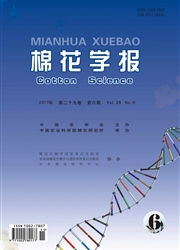

 中文摘要:
中文摘要:
为了研究黄萎病菌侵染条件下内生细菌群落结构多样性变化,以不同时期健康棉株和感染黄萎病菌(Verticillium dahliae)的棉株根部组织为材料,提取样品总DNA,扩增内生细菌16S r DNA的V3可变区,将扩增产物进行变性梯度凝胶电泳分析,并对21个优势条带进行切胶回收、克隆测序,构建系统发育树。结果表明:不同时期发病棉株和健康棉株样品可以聚成2大类,一是苗期和蕾期的根部样品,二是初花期和结铃期的根部样品;感染黄萎病棉株内生细菌种类多样性下降;BLAST比对结果发现21个克隆序列与Gen Bank数据库中已知16S r DNA基因序列同源性很高(99%~100%),绝大多数属于变形菌门(Proteobacteria),占总克隆序列的80.95%,其他不可培养细菌占19.05%。说明黄萎病菌的侵染能明显影响内生细菌群落结构多样性。
 英文摘要:
英文摘要:
The endophytic bacterial communities in cotton roots infected with Verticillium dahliae were studied by extracting total DNA from the roots of healthy and infected plants. The V3 region of 16 S r DNA was amplified and analyzed by denaturing gradient gel electrophoresis(DGGE). The 21 predominant bands were then sequenced. According to the phylogenic analysis, the samples at different periods were divided into two clusters. One cluster is the root samples from plants at the seedling and bud stages, the other is the root samples from plants at the flowering and boll setting stages. Overall, the diversity of endophytic bacterial communities decreased in the roots of cotton plants infected with V. dahliae. Sequence alignments in Gen Bank revealed that the majority of the bands(80.95%) belong to Proteobacteria and the rest(19.05%) were uncultured bacteria. The results showed that the diversity of the endophytic bacterial communities in cotton appeared to be influenced by V. dahliae.
 同期刊论文项目
同期刊论文项目
 同项目期刊论文
同项目期刊论文
 期刊信息
期刊信息
